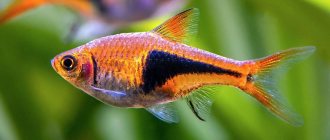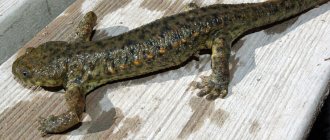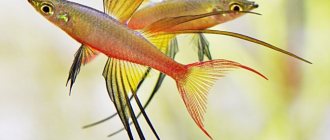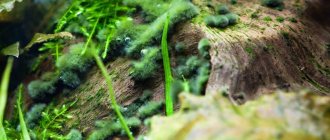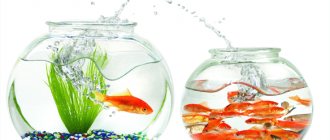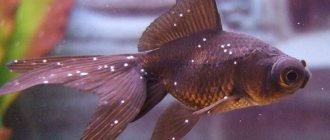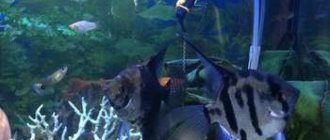Brigitte's rasbora (Boraras brigittae) Vogt, 1978
Synonyms
Russian: Dwarf rasbora, Rasbora mosquito, Boraras brigitta Latin: Rasbora brigittae, Rasbora urophthalma brigittae
Etymology
Boraras: An anagram of the genus name Rasbora, referring to the inverse ratio of ventral to caudal vertebrae in the genus. brigittae: named after the author's wife.
Family: Cyprinidae Genus: Boraras
Range and Habitat
Brigitte's rasbora (Boraras brigittae) distribution areas.
Natural habitat: swamps of Southwestern Borneo, Indonesia.
Brigitte's rasbora (B. brigittae) habitat, surroundings of Sabang
Inhabits black water streams and rivers associated with ancient forested peat bogs. The water turns dark brown due to tannins and other substances released when organic matter decomposes - fallen leaves, twigs and snags.
Brigitte's rasbora (Boraras brigittae) habitat, biotope
Such biotopes usually have very soft (negligible hardness), acidic (pH only 4.0) water and are often poorly lit due to the forest canopy.
Description
The body has a clearly defined green-black stripe just below the lateral line, around which there are bright red or orange stripes. The line ends in a black wedge-shaped point at the beginning of the caudal fin.
Brigitte's rasbora (B. brigittae) appearance, dominant male
In males, red coloring can be all over the body, its brightness will only increase with age. In general, males are brighter, redder, and more contrasting than females, whose coloring is predominantly pinkish and orange. The dominant male literally blazes with red fire all over his body, while males of a lower rank are not so picturesque.
Size:
Grows to a maximum size of 25 mm.
Neighborhood
Rasbora brigitta is a peaceful fish, but its miniature size makes it possible to become a victim of larger fish. You can keep different types of tiny fish in one vessel; the ideal neighbors would be fish like cardinals. Shrimp can be wonderful neighbors for tiny fish, which will perfectly complement the composition of a nano-style aquarium. Larger neighbors may be herbivorous chain catfish.
Rasbora is a schooling fish; when you start breeding them, you need to start breeding them in schools of at least 10-12 individuals; when there are fewer of them, they behave timidly and hide in the thickets. In a small flock, the hierarchy is poorly expressed; the dominant, brightest and most active male is little noticeable.
Behavior and Compatibility
Schooling fish that prefer to stay in a group of 8 or more individuals.
Boraras are very beautiful and each species is interesting in its own way. This feature makes fish excellent objects for both a species aquarium and a small community aquarium. Fish are also great for nano aquariums. This fish can be kept with other peaceful fish of the same size, as well as in shrimp tanks. You will not be successful if you keep them with large or aggressive fish, they will spend all their time in thickets or other cover, because no one wants to be eaten.
Rasbora brigittae (B. brigittae) in an aquarium, content 1
Can be kept with many other similar fish species and larger Characins. Some of the fish that can be safely kept together with microrasbors are loricariid catfish species - otocinclus, ancistrus, etc. Freshwater shrimp of the genera Caridina and Neocaridina will be excellent neighbors.
Brigitte's rasbora (B. brigittae) in an aquarium, content 2
The fish is quite nimble and you can admire it for hours, a fish with character and unique behavior.
Rasbora brigittae (B. brigittae) in an aquarium, content 3
Adult fish in the aquarium are kept in its upper part, while the dominant male controls about a quarter of the entire territory; he protects his possessions from encroachment by other fish. His courtship of females and “battles” with males look like this: standing next to another fish, head to head or head to tail, he begins to “whip” his fins and body towards the opponent, his coloring at this time becomes more and more intense. At the same time, the fish do not cause any physical harm to each other.
Feeding
Due to the very small size of Brigitta's rasbora, feeding is somewhat unconventional. It is necessary to take into account that the pet’s mouth is so small that even a small bloodworm is too big for them . The fish diet should consist of the following types of food:
- phytoplankton;
- zooplankton;
- very small insect larvae or small bloodworms cut in half;
- vegetable flakes, which must be thoroughly crushed before giving, but not to a powder state;
- artificial dry food in flakes, which is crushed before feeding.
Video: feeding Brigitte's rasbor
Giving fish monotonous food is extremely undesirable, since if there is a deficiency of vitamins and minerals in the body, the fish not only fade, but also begin to get sick.
Aquarium
It is better to keep the group in a small species aquarium with a base size of at least 45 * 30 cm, with dark soil, although a flock of these dwarf rasboras, due to their bright colors, will not get lost even in a relatively large aquarium.
The aquarium should have a lot of small-leafed plants and plants that float on the surface of the water, among which they like to swim. It’s good if you can organize brightly and dimly lit areas in it. Small cyprinids have developed bright signal colors in order to compete with each other in brightly lit areas, and in case of danger they hide in the shadows.
Brigitte's rasbora (Boraras brigittae) aquarium, biotope 1
The filtration should not be particularly strong, since these fish mainly come from slow-moving waters. If you also use dim lighting, you will get an almost natural biotope in which fish live in nature. You can add some Asian plants that can grow successfully in such conditions, such as Microsorum pteropus, Taxiphyllum barbieri or Cryptocorynes. Use different types of moss to decorate your aquarium. A few tufts of floating vegetation will be very helpful and will diffuse the light entering the aquarium.
Brigitte's rasbora (Boraras brigittae) aquarium, biotope 2
The water is soft, with the addition of peat decoction or black water preparations. The addition of dry leaves (oak or Ketapang-almond) can further enhance the resemblance to the natural habitat and provide additional cover for fish. The leaves can be left in the aquarium until completely dissolved or replaced every few weeks.
Water parameters:
Temperature: 23 - 28° C pH: 6.0 - 7.0 Hardness: about 10° dGH
About a third of the water volume should be changed once every 7-10 days.
Do not introduce fish into biologically immature aquariums, as they are sensitive to fluctuations in water chemistry.
Aquarium Basics
Microrasboras are not difficult to keep, however, when keeping them as pets, it would be useful to follow some recommendations:
- The dimensions of the aquarium should be selected based on the size of the flock, however, you should not crowd the Boraras at all. Thus, even small species (the body length of which is up to 2 cm) can only be housed in tanks with a volume of 30 liters or more (preferably at the rate of 1 liter of liquid per individual). Due to the jumping ability of fish, it is necessary to organize an upper ceiling for the tank.
- Environment parameters: temperature 20… 25 °C; hardness – 7 dH; acidity – 6.5-7.5 pH. A weekly change of a third of the water volume is required. Good filtration and aeration are necessary, however, while avoiding the formation of increased liquid fluidity. It is worthwhile to periodically clean the substrate thoroughly.
- Landscaping: Dense, providing plenty of cover, reducing open space to an average or minimum. Plants can be either floating or fixed in the ground. Shade-loving.
- Soft sandy substrate, the thickness of which is selected based on the characteristics of the algae, but not less than 3 cm.
- Decor: driftwood, small caves, stones, etc.
- Lighting: diffused, low intensity.
| Temperature | Rigidity | pH |
| 23-25 | 4-7 | 4-7 |
For a school of fish of 12 individuals (the recommended minimum number for the normal psychological state of fish), an aquarium with a volume of 50 liters or more is sufficient. The background in it is preferably dark, as this will emphasize the intensity of the color of the fish. It is advisable not to make the bottom motley, but rather to give preference to natural, non-light soil.
Despite the fact that in nature there are few plants in the reservoirs where Brigitta's rasbora lives, for comfortable keeping in the aquarium they will need to create fairly dense thickets, since small pets need shelters, which will serve as plants. Enough space should be left along the front glass for these active fish to swim freely.
Plants will help these small fish protect themselves from other inhabitants of the aquarium.
Installing a filter in the aquarium is mandatory. You can use the internal or external design of this device with equal success.
It is only important to adjust it in such a way that the flow of water does not disturb the mosquito fish
Maintenance must be regular to ensure the proper condition of the pond. To maintain good water quality in the aquarium, it is partially changed every week. Replacement volume is 25%. Water changes are combined with cleaning, during which fish waste and dead parts of aquatic plants are removed from the bottom.
Sexual Dimorphism
Males are smaller, narrow-bodied, and brighter in color. The color of females is predominantly yellowish, with almost no red.
Brigitte's rasbora (B. brigittae) male, difference, appearance
Brigitte's rasbora (B. brigittae) female, difference, appearance
They become sexually mature at 6-7 months.
Breeding
Breeding is not particularly difficult. In well-maintained, mature aquariums, a small number of fry may begin to emerge without human intervention. The main condition is the presence of shelters for the larvae, for example Java moss and riccia.
The male, with a kind of dance, separates the female he likes from the rest of the group and gradually takes her to a secluded corner of the aquarium. In the thick of plants, the female spawns, sometimes being on top of the plants, and sometimes below them, while turning over with her belly up. The spawning process occurs almost daily and mainly in the early morning, at the first rays of the sun.
The hatched larvae are simply incredibly small, making them out to be a very difficult task. For several days they hang on the leaves of plants, feeding on the contents of their yolk sac. After 4 days, the larvae are already trying to swim, first going up and then going down. And already on the next 5th day, many of them take a horizontal position. From this time on, the fry swim almost all the time and spend most of the time in thickets of plants. At this moment they are almost completely transparent.
If you want to increase the number of fry, a slightly more controlled approach is required.
Breeding in spawning tank:
The preparation of producers consists of feeding them cyclops and brine shrimp for several weeks.
As a spawning ground, use a small aquarium with a length of 20 cm. Soft water, with the addition of a decoction of alder cones or black water preparations: pH 5.0-6.5; 1-5°dGH; temperature 26-28. Filtration is not really necessary, but you can use small airlift sponges. You can put a separator mesh. The lighting is dim. 2-3 pairs of producers are selected for spawning. From the moment the first eggs appear, the pairs should be left for several days before being removed.
It is clear that such tiny fish have very little eggs. One female lays 30-50 eggs. The caviar is transparent, slightly yellowish, small, remains on small-leaved plants or synthetic fibers and falls to the bottom without sticking. The incubation period is a little more than a day, and after 5 days the fry begin to be fed first with live dust, then with Artemia nauplii. The fry are small, so problems with feeding at the first stage are quite noticeable. It is a good idea to add more Java moss to the nursery tank and add live dust. In this case, the fry collect small food in the thick of the moss, which is detritus and microorganisms.
Rasbora brigittae (B. brigittae) is an excellent choice for an aquarium.
Under favorable conditions, life expectancy is about 3 - 5 years.
Notes
A similar species, the Rasbora firefly (Boraras urophthalmoides), has a paler, almost transparent body, a pattern on the body in the form of two stripes, one thick black and golden on top.
Rasbora firefly (Boraras urophthalmoides) similar species
B. urophthalmoides is often sold as B. brigittae, presumably to get a better price. Although they are similar in that they are the only two members of the genus that have a dark lateral stripe on their body. B. brigittae is easily identified by its larger adult size, lack of a distinct dark spot on the caudal peduncle, relatively short, often discontinuous lateral stripe, and overall brighter, more uniform red coloration.
The genus Boraras was formed in 1993 to separate a small group of species from the larger Rasbora group based on differences in body structure and mode of reproduction.
Small adult size in Boraras species evolved through a process known as miniaturization, which is characterized by sexually mature adults with a significantly reduced size of less than 20 mm.
Boraras species from the Malay Archipelago (B. brigittae, B. maculatus and B. merah) have a thinner and more elongated body profile than those of the Indochinese (B. micros, B. urophthalmoides, B. naevus), which can help in identifying their.
Appearance
On average, boraras brigittae will grow to only 2.5 cm. All representatives of this species are very beautiful and will decorate your small aquarium. As you watch them, you will distinguish and recognize some by their colors. The dark stripe on the fish’s body runs slightly below the middle of the body. Along the edges of the dark stripe, most have bright orange stripes, while the dominant male has fiery red stripes.
The stripe stretches to the root of the tail and ends there with a black circle, it resembles a wedge. The body of the fish is red and the older the individual, the brighter the color. Females have a main color or a less intense orange or pale pink, which is also very beautiful. And the dominant male is the most noticeable with a bright, glowing red color on his body. Other males have more modest, paler colors. Mature females are slightly larger than males. This is how nature intended. Their abdomen is round
